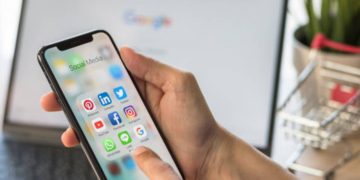SHANGHAI, CHINA – 2019/09/20: Apple’s iPhone 11 Pro Max which features triple rear cameras seen at an Apple retail store at the IFC Mall in Pudong New Area, Shanghai. Apple launched sales of its latest iPhone 11 series in China. (Photo by Alex Tai/SOPA Images/LightRocket via Getty Images) (Getty Images)
Have you ever lost your phone? There’s that sinking feeling when you realize it’s nowhere to be found.
There are better ways to find a lost phone than getting someone to call it for you. Tap or click for methods to find your misplaced smartphone, even if it’s powered down.
We store so much valuable info on our phones, from our credit card details to our email to our most personal photos and conversations. Tap or click for five security steps you can take to protect it all, even if your phone ends up in the wrong hands.
It’s best to back up your photos, so they’re safe and sound — no matter what happens to your device. The method is up to you. Just don’t wait till it’s too late.
Put them in the cloud
Both Android and iOS let you back up your photos to the cloud for safekeeping. It’s easy, and you don’t have to install extra software to do it.
On an iPhone:
- Open Settings on your device and tap your name at the top.
- Tap iCloud, then tap Photos.
- Turn on iCloud Photos to start saving your photos to the cloud.
The process may take some time to complete. Once it’s finished, any photos you take will be automatically saved to the cloud. You can also view them on your desktop by signing in to iCloud.com with your Apple ID.
On Android:
- Open the Google Photos app and sign in if you need to.
- On the top right, tap your account photo or initial.
- Select Photos settings, followed by Back up and sync.
- Toggle Back up and sync on.
Once your backup is done, future photos you take will be saved to the cloud. You can view, edit, and sort them inside the Google Photos app and see them from your desktop at Google.com/photos.

Note: iCloud and Google Photos come with limited free storage. More will cost you 99 cents to $1.99 per month.
Good news if you have an Amazon Prime account:
Amazon Photos offers free unlimited, full-resolution photo storage, plus 5 GB of video storage for Prime members. Tap or click here to get a 30-day free trial if you want to try it out.
FIND THE SHOT: Have you ever lost time searching for a photo you know is hiding in your gallery? Here’s a simple trick that works for iPhones and Androids.

Here’s one way you shouldn’t store photos
It’s tempting to store your photos on a thumb drive. They’re small and lightweight — and that makes them easy to lose. Plus, the cheapest drives don’t usually have any encryption or password protection. Think about how you’d feel if someone swiped yours.
More expensive drives like the USB-powered PhotoStick are explicitly marketed for photo backups. For the most part, it’s a 128GB flash drive. It’s lightweight, easy to lose, and doesn’t offer any security.
The big selling point is its onboard software that shows you how to move your photos. But Amazon reviewers are mixed. I’ll leave that choice up to you.
So how can you use all those thumb drives you have sitting around? Here are some clever ideas, including creating a Windows recovery drive, scanning for viruses, and using it as a key that unlocks your PC.
For a physical backup, go with a secure external drive
If you want to store your photos physically, a secure external drive is a better choice. These devices tend to have higher storage capacity and faster speeds, plus they’re harder to lose. They’re also cheaper now than they were years ago.
This external hard drive from Seagate gives you reliable performance and speed for its size. The hard drive has 2TB of storage, which means you can fit up to 500,000 photos.
This external drive from LaCie comes with a cushioned exterior to protect it from drops and bumps. If you’re worried about breaking your hard drive and losing your photos, this rugged 2TB device is a perfect choice.
If you’re looking for something a bit more secure, go with an encrypted external drive. This hard drive from Apricorn features a 10-digit keypad that protects the contents from being read. You can only get in if you know the code — which means your files are safe if the hard drive is lost or stolen. How cool is that?
You have no excuse now that you know how easy it is to get your photos off your phone. Take some time to protect your memories. Otherwise, you could be out of luck the next time your phone breaks, is lost or stolen.

Woman using smartphone on a wooden desk.
Bonus Tip: SEO 101: How to get more people to your website
If you have a website, you want it to show up on the first page of Google for as many different search terms as possible. How can you get there? SEO, or search engine optimization, is the secret sauce that stands between you and ranking highly. I chat with SEO expert Steve Wiideman about the insider secrets to boost your rankings and make more money online.
Check out my podcast “Kim Komando Explains” on Apple, Google Podcasts, Spotify, or your favorite podcast player.
Listen to the podcast here or wherever you get your podcasts. Just search for my last name, “Komando.”
What digital lifestyle questions do you have? Call Kim’s national radio show and tap or click here to find it on your local radio station. You can listen to or watch The Kim Komando Show on your phone, tablet, television, or computer. Or tap or click here for Kim’s free podcasts.
Copyright 2022, WestStar Multimedia Entertainment. All rights reserved. By clicking the shopping links, you’re supporting my research. As an Amazon Associate, I earn a small commission from qualifying purchases. I only recommend products I believe in.
Learn about all the latest technology on The Kim Komando Show, the nation’s largest weekend radio talk show. Kim takes calls and dispenses advice on today’s digital lifestyle, from smartphones and tablets to online privacy and data hacks. For her daily tips, free newsletters, and more, visit her website at Komando.com.
Source by www.foxnews.com















































